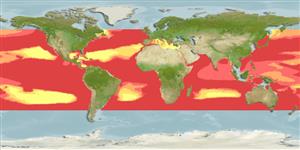Common names from other countries
>
Anguilliformes (Eels and morays) >
Nemichthyidae (Snipe eels)
Etymology: Nemichthys: Greek, nema, -atos = filament + Greek, ichthys = fish (Ref. 45335); scolopaceus: From the Latin 'scolopax' referring to the long bill-like jaws (Ref. 6885).
More on author: Richardson.
Environment: milieu / climate zone / depth range / distribution range
Sinh thái học
Biển Tầng nổi biển sâu; Mức độ sâu 0 - 4337 m (Ref. 96339), usually 100 - 1000 m (Ref. 58302). Deep-water; 55°N - 42°S, 180°W - 180°E
Worldwide in tropical and temperate seas. Western Atlantic: Nova Scotia, Canada and northern Gulf of Mexico to Brazil. Eastern Atlantic: Spain to South Africa, including western Mediterranean (Ref. 3247); reported from Iceland (Ref. 12462). Regularly found in the Skagerrak (Ref. 35387). Northwest Pacific: Japan (Ref. 6885) and Arafura Sea (Ref. 9819). Eastern Pacific: Alaska (Ref. 6885) to Chile (Ref. 9068), including the Gulf of California (Ref. 32364).
Bộ gần gũi / Khối lượng (Trọng lượng) / Age
Maturity: Lm ? range ? - ? cm
Max length : 130 cm TL con đực/không giới tính; (Ref. 35388)
Các tia vây lưng cứng (tổng cộng) : 0; Tia cứng vây hậu môn: 0. Jaws long (Ref. 13608). Posterior end of body narrow, ending as a long filament (Ref. 13608). Dorsal fin with about 350 rays; caudal fin not recognizable; anal fin with about 320 (Ref. 6885). Dark brown or grey in color, often darker below (Ref. 3248); anal fin and tips of pectoral fins almost black (Ref. 6885).
Occur in midwater, usually below 400 m and occasionally in shallow water in the northern part of its range. Feed on crustaceans while swimming with its mouth open (Ref. 5377). Mesopelagic (Ref. 58302) and bathypelagic (Ref. 58426). Oviparous, with planktonic leptocephali (Ref. 32364). Degenerative changes in males and females suggest semelparity (Ref. 32364). Minimum depth reported taken from Ref. 86942.
Life cycle and mating behavior
Maturities | Sự tái sinh sản | Spawnings | Egg(s) | Fecundities | Ấu trùng
Nielsen, J.G. and D.G. Smith, 1978. The eel family Nemichthyidae (Pisces, Anguilliformes). Carlsberg Found., Dana-Rept. No. 88:71 p. (Ref. 7450)
IUCN Red List Status (Ref. 130435)
CITES (Ref. 128078)
Not Evaluated
Threat to humans
Harmless
Human uses
Các nghề cá: không ích lợi (thú vị)
Các công cụ
Special reports
Download XML
Các nguồn internet
Estimates based on models
Preferred temperature (Ref.
115969): 4.3 - 21.1, mean 10.2 (based on 3474 cells).
Phylogenetic diversity index (Ref.
82804): PD
50 = 0.6270 [Uniqueness, from 0.5 = low to 2.0 = high].
Bayesian length-weight: a=0.00102 (0.00046 - 0.00225), b=3.06 (2.88 - 3.24), in cm Total Length, based on all LWR estimates for this body shape (Ref.
93245).
Mức dinh dưỡng (Ref.
69278): 3.5 ±0.0 se; based on diet studies.
Thích nghi nhanh (Ref.
120179): thấp, thời gian nhân đôi của chủng quần tối thiểu là 4.5 - 14 năm (K=0.30; assuming semelparity with tm>5).
Fishing Vulnerability (Ref.
59153): Moderate to high vulnerability (51 of 100).
